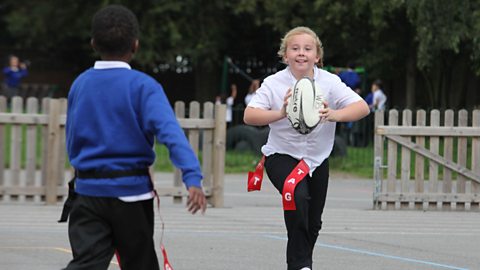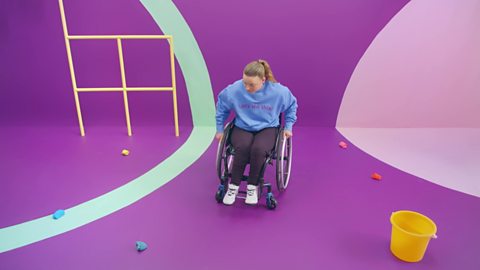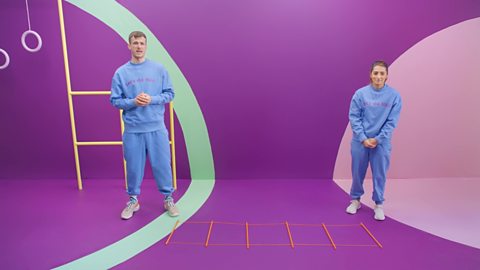Let's get active and try North, South, East, West!
With the North, South, East, West activity you can develop the following skills:
- Balance and control
- Coordination and fluency
- Jumping power
- Stamina and endurance
This resource is suitable for Physical Education and activity for P2, P3, P4, P5, P6 and P7 (First and Second Level Curriculum for Excellence).
Watch this
Learn how to take part in the North, South, East, West activity with help from primary school teacher, Danny Denholm.
DANNY: Hey, I'm Danny, and welcome to Let's do this, where we will get active together.
This activity is called North, South, East, West. This activity will develop your balance and control, and your stamina.
You will need a partner, cones or socks.
Fortunately, I've got some help today from Jarrell and Ella to help me show you what we are going to do.
Step one, mark cones with the points of the compass; North, South, East, and West. Set them out in a diamond shape around one meter apart.
Step two, player one starts in the centre of the diamond.
Step three, player two shouts either North, South, East, or West.
ELLA: North.
DANNY: Step four, player one jumps with two feet towards that cone, then returns back to the middle.
Now, that was a lot of steps, so let us show you how to do it first.
Let's do this!
ELLA: West. East. South. North.
DANNY: Let's see you give this a go.
NARRATOR: Too tough?
DANNY: Too tough? Change the distance between the cones, so you don't have to jump as far, or move in a way that feels more comfortable.
If you struggle, remember the directions. You can use four different coloured markers instead for the compass directions.
NARRATOR: Go up a notch?
DANNY: Want to develop your skills? There are several ways you can take this up a notch.
Firstly, increase the distance between cones, so that the moving player is running.
Instead of turning round, keep facing your partner, so you have to jump forward, sideways, or backwards. This is great for improving agility, but make sure you are careful with your movements in this one.
This activity could be made more sport specific by having the moving player lunge towards the cones. For example, when you lunge forward to reach a shuttlecock in badminton, or a ball in tennis.
Great effort, guys.
Now, you give it a try.
NARRATOR: Danny's challenge.
DANNY: For my challenge, count how many jumps you can get in 30 seconds.
NARRATOR: Final thoughts.
DANNY: This activity will improve your stamina in PE, sport, and in our day to day lives. For example, climbing a steep set of stairs or running around with your friends. Can you think of another activity where good stamina would be useful?
NARRATOR: Let's do this!
What you need
| Equipment | Alternatives |
|---|---|
| Cones | Balled-up socks, tins or pieces of paper |
Try it yourself
Follow these step-by-step instructions and give it a go!

Image caption, Get ready
Set your cones out in a diamond shape around 1 metre apart. If you don't have cones, you can use balled-up socks, tins or pieces of paper as markers. These will be your compass points. The first player (the caller) stands to the side ready to call out directions. The second player (the moving player) starts in the centre of the diamond.
Image caption, Player 1: Shout a compass direction
The caller chooses a compass point and shouts either North, South, East, West.
Image caption, Player 2: Move towards the compass point
The moving player moves towards the direction given by the caller then return back to the middle. You can jump with two feet or move in any way that feels comfortable.
Image caption, Keep going!
After returning to your starting position, repeat these steps. You can take turns to be the moving player or the caller.
1 of 4
Don't have a partner?
If you want to practise this on your own, you don't need a partner to shout the directions. You can choose your own compass directions to move towards.
How was North, South, East, West for you?
We are all unique and have different strengths and skills. Some of us may find some skills easier than others but we can all develop and improve.
You can adapt the North, South, East, West activity to suit your needs. If we practise our skills regularly, we can improve and progress over time.
Too tough?
If you find the North, South, East, West too challenging, don't worry!
Try these tips to make the activity a bit easier.
- Shorten the distance between the cones.
- Move in a way that feels more comfortable for you.
- If you struggle remembering the directions, you can use four different coloured cones instead so the caller will shout a colour to move towards instead of a compass point.
Go up a notch?
It's great to look at ways to develop our skills and we can do this by challenging ourselves.
If you enjoyed the North, South, East, West but are looking for a bigger challenge, try these tips to make it trickier.
- Increase the distance between cones so that the moving player has to run to them.
- Instead of turning round, keep facing your partner so you have to jump forwards to north, sideways to east and west or backwards to south.
- Make the activity more sport specific by having the moving player lunge and tap cones.
Danny's challenge
Set yourself a time challenge.
Count how many jumps you can get in 30 seconds.
Keep a record of your score and try to beat it next time you play.
Time to reflect
Enjoyment
The most important part of physical activity and movement is that you enjoy it. We all need to stay active in our daily lives in order to stay healthy. It’s a lot easier if you’re having fun.
After you’ve taken part in this activity, take some time to think about what you enjoyed and how you might approach the activity differently next time.
- What did you enjoy about this activity? How could you do more of this?
- What did you dislike about this activity? What would make it better?
- What would you do differently next time?
Developing your skills
The skills you’ve worked on in this activity are useful in other parts of your daily life and in sport.
Can you think of any activities or sports where you might use these skills?
The skills you've developed in this activity could help with:
- performing and landing a jump
- giving and listening to instructions
- revising the compass points
Physical activity skills. listPhysical activity skills
Learn more about the different skills you've developed in this activity and how we use them in daily life.

Athletics Training with Eilidh Doyle. videoAthletics Training with Eilidh Doyle
Continue to develop your skills with some drills to help you keep fit and start hurdling.

Understanding compass points. revision-guideUnderstanding compass points
Let's find out how to use a compass when reading a map.

More on Physical activity
Find out more by working through a topic
- count5 of 18

- count6 of 18

- count7 of 18

- count8 of 18

